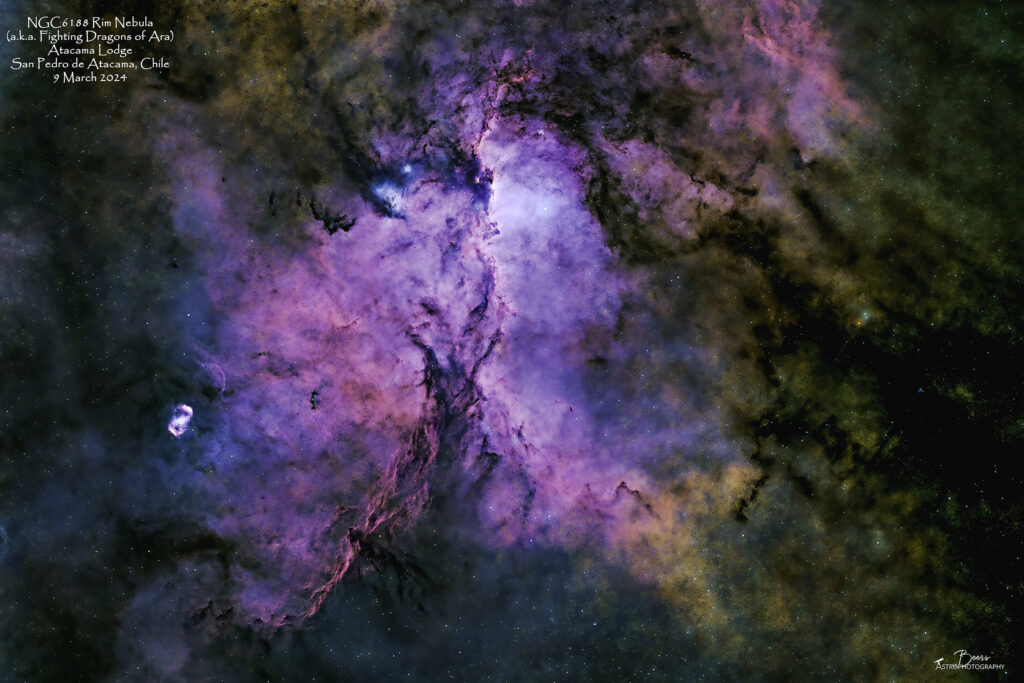
Fun facts
NGC 6188 is an emission nebula located about 4,000 light years away in the constellation Ara. The bright open cluster NGC 6193, visible to the naked eye, is responsible for a region of reflection nebulosity within NGC 6188.
NGC 6188 is a star forming nebula, and is sculpted by the massive, young stars that have recently formed there – some are only a few million years old. This spark of formation was probably caused when the last batch of stars went supernova.
Distance: 4000 light years
Radius: 300 light years
Apparent Dimensions: 20′ x 12′
Constellation: Ara
{ From: https://en.wikipedia.org/wiki/NGC_6188 }
Capture & Processing Notes
Motivated by Alain Maury’s star tour a few night before, where we were treated to a viewing of the Tarantula Nebula through his 45″ telescope – I spent night #4 of the Atacama Desert trip capturing two targets – 52x5min on NGC2070 Tarantula Nebula from dark until it set at about 0200. Then, I took advantage of the rest of the darkness by gathering 53x5min on NGC6188 Fighting Dragons of Ara from 0200 until 0640, the end of astronomical twilight.
For NGC6188 (forgot to do it for NGC2070 at the start of the evening), I reset PHD2 deleting the checkmark on “restore calibration” to allow PHD2 to go through its calibration activities to avoid the “too close to the equator, calibration is required.” I also enabled autofocus at the 60-minute mark, since the autofocusing has been going so well and not creating any errors. I noted at the end of the night, that the autofocus process added, for a 4:30 hour sequence, about 17 minutes to the capture. So the autofocus seems to be taking approximately 5 minutes per hour. It is probably worth doing when the temperature is changing throughout the night (like it was here), but not when it is cold throughout.
Sequence Plan:
- Sequence plan: Gain: 158, Temp: -0°C, offset=30; Captured 52x5min; Total exposure time: 260 minutes, 4:20 hours.
- Captured: Night of 9 March 2024 (10Mar2024, 0205CDT – 10Mar2024, 0647CDT);
- Shooting location: Atacama Lodge, San Pedro de Atacama, Chile
Processing summary: Captured with SGP. Stacked in APP. Star removal with Starnet++. Processed in LR/PS
Equipment
All equipment controlled by HP Probook (DSO CTRL 1) Windows 10 laptop running Sequence Generator Pro v4.3.0.1305.
- Polar alignment: QHYCCD camera (controlled by Polemaster for polar alignment)
- Imaging: (Southern Cross) Askar FRA600 on Rainbow Astro RC-135E, ZWO ASI2400MC#1 camera
- Autofocuser: ZWO EAF ( Electronic Automatic Focuser)
- Mount: Rainbow Astro RST-135E (controlled by iHubo ASCOM driver)
- Autoguiding: Orion 60mm Multi-Use Guide Scope with Orion StarShoot AutoGuider Pro Mono Astrophotography Camera (controlled by PHD2)
